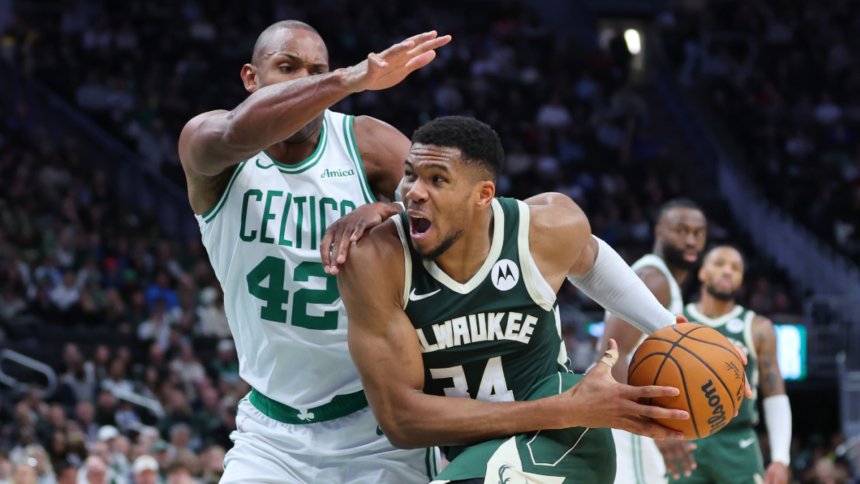
If you just looked at Giannis Antetokounmpo’s stats in a vacuum, you’d assume he was well on his way to a third MVP season. He entered Sunday averaging more points (30.1) on a higher field goal percentage (60.5) than he had in either of his first two MVP seasons. And while his 12.8 rebounds and 5.3 assists don’t beat his MVP paces, they’re not exactly far off.
The Milwaukee Bucks have arguably the best basketball player in the world. They’ve also lost eight of their first 10 games.
Sunday painted a pretty clear picture of how exactly those two sentences can coexist. Antetokounmpo was, once again, brilliant. He put up 43 points, 13 rebounds and five assists against the Boston Celtics, but Milwaukee lost 113-107. Milwaukee’s four other starters, Damian Lillard, Brook Lopez, Taurean Prince and Andre Jackson, combined to make half as many field goals (9) as Antetokounmpo (18). He topped 40 points. No other Buck reached 20.
Take a look through Milwaukee’s game logs and you’ll see plenty of somewhat similar nights. In the Bucks’ first loss against Chicago, Antetokounmpo and Lillard combined to score more than 62% of their points. Nobody else reached a dozen. How about his 34-point, 16-rebound, nine-assist masterpiece against the Cavaliers? He and Lillard combined for 75. Their teammates scored 38.
Lillard is often the outlier here, but not nearly as reliably as he needs to be. His performance of just four points on 1-of-12 shooting against the Grizzlies went a long way toward costing Antetokounmpo a victory in game in which he made 17 of his 22 shots. In Sunday’s loss, Boston hunted Lillard relentlessly in the pick-and-roll. They were far from the first team to do so. Milwaukee’s defense allows 12.9 points per 100 possessions fewer when he is on the bench.
Those defensive woes were predictable and Lillard was far from the only culprit. There’s a much bigger and simpler problem here than any specific flaw. Antetokounmpo is an MVP-caliber player most of the time. Lillard, as was the case a year ago, vacillates between his former All-NBA form and something significantly weaker seemingly at random. As for the rest of the Bucks? Well, Milwaukee just doesn’t have many good players. They are, thus far, operating at an enormous talent deficit.
Bleacher Report’s Andy Bailey frequently aggregates the combined rankings for every NBA player among six of the most common catch-all advanced metrics (BPM, VORP, EPM, LEBRON, Game Score per minute and Total Game score) and then lists a team’s players by the average of their league-wide ranks. By these metrics, the Bucks have two players who rank in the top 10 thus far this season, Antetokounmpo at No. 5 and Lillard at No. 10. They have no other players in the top 100. A.J. Green is next at No. 116, but he plays only around 14 minutes per game. To find another Bucks player, you have to go all the way down to No. 193, Brook Lopez. Everyone else is in the 200s.
You can solve specific roster issues. If your problem is defense, you can tinker with lineups and schemes and at least optimize what you have. But fixing a talent problem is much trickier. It usually requires someone else’s cooperation on the trade market. The Bucks are reportedly doing their best on that front, but are running into compliance issues as much as value negotiations.
ESPN’s Brian Windhorst summed it up well on NBA Today on Friday: “I talked to one team who said, ‘yeah, we talked to the Bucks, we came up with like two or three different scenarios, and we realized we’re not allowed to make any of those trades.’ The Bucks are hemmed in as a second-apron team.”
Because of that second apron, the Bucks can neither aggregate salaries for the purpose of a trade nor take in more money than they send out. They don’t own any first-round picks until 2031. With how limited the value of most of their players is, it’s hard to imagine them trading many of them for something notable. Windhorst, unsurprisingly, did not “think help is on the way.”
Those financial constraints made improving the roster this offseason nearly impossible. The Bucks drew plaudits for signing Taurean Prince, Gary Trent Jr. and Delon Wright to minimum-salary deals this offseason. You could argue that all three were worth more than the minimum, but they still signed for the minimum for a reason. Even if they create surplus value on top of it, these are not game-changing players. Lopez is 36 and finally starting to show meaningful signs of decline, especially on defense. He led the league in contested shots in five of the past six seasons. At his peak, he was contesting 19.3 of them per game. This season? He’s down to 11.7, according to NBA.com tracking data. And to make matters worse, Khris Middleton hasn’t played yet after missing 76 games in the past two seasons.
The NBA is deeper than it’s ever been. Look at the teams who have outperformed expectations thus far this season. The 7-2 Golden State Warriors have notably used 11- and 12-man rotations. The undefeated Cleveland Cavaliers kept all four of their core players despite calls for an offseason breakup designed to emphasize fit. Instead, they’ve improved on the wings and perimeter by developing players internally (Dean Wade, Isaac Okoro, Sam Merrill) and finding gems on the margins (Ty Jerome, Caris LeVert).
The Bucks tried to build a top-heavy roster when they landed Lillard. For that plan to work, they needed Lillard to be consistently great and both Lopez and Middleton to be consistently good and available. None of that has happened thus far, and it has made life that much harder for Milwaukee’s less-talented supporting cast.
Put all of that together and it doesn’t matter how dominant Antetokounmpo looks. The Bucks won’t be able to put a serious contender around him.







